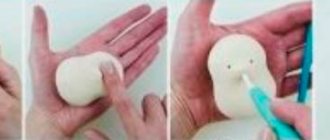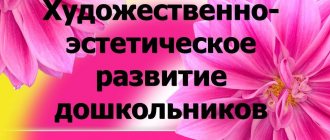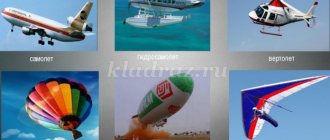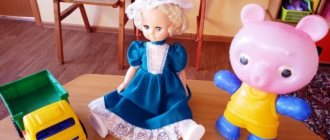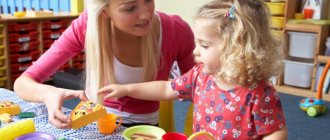On the topic: methodological developments, presentations and notes
Plan of drawing notes (preparatory group) on the topic: “Winter Landscape” using the non-traditional “Imprint” technique (drawing with vegetables).
Program content: Learn to draw rowan, highlighting the characteristic features of the bunch. Reinforce the idea of the color red; cultivate interest in collective creativity. Continue learning doat.
MBDOU "CRR - kindergarten "Bell" Summary of direct educational activities in drawing in the 1st junior group "Winnie the Pooh" Topic: "Wheels for the train" (non-trad.
summary of a drawing lesson in the junior group “Beasts in the Forest.”
Drawing outline for Cosmonaut Day using non-traditional drawing techniques.
Source
What nuances are taken into account when preparing a lesson on drawing clothes?
The goals of depicting clothing, shoes and hats in the older group are:
- acquaintance with the history of the development of costume, as well as the features of folk elements in clothing,
- working with templates and creating your own sketches of wardrobe items,
- explanation of the rules for choosing clothes for different seasons, life situations (on the occasion of a celebration - bright, festive, for a walk - casual, etc.),
- enriching knowledge regarding professions related to the creation of clothing (shoemakers, fashion designers, tailors, cutters, etc.),
- nurturing a sense of proportion and harmony when selecting decorative elements of a costume.
Drawing clothes gives children the opportunity to choose their own color schemes for coloring, and then evaluate the result from the point of view of aesthetics
What is needed for the lesson
Wardrobe items are usually depicted on sheets of standard white A4 paper. An important nuance: if the drawing is intended to be painted, then the sheet should be tinted only with pale pastel colors. The image will be “lost” on a bright background. If the drawing is supposed to be decorative, then you can use ready-made templates, which the guys paint in accordance with the assignment. For example, Slavic patterns of folk costume in the theme “Fabric Painting”.
Drawing is an important activity for children with mental retardation. However, due to limited capabilities, such children may not be able to create a drawing “from scratch,” so the teacher actively involves working with templates that need to be painted, decorated, or supplemented with missing lines, for example, to complete the top line for the crown of a hat.
For drawing in the senior group on the topic “Clothes, shoes and hats”, as well as for other topics, colored pencils, paints (watercolor and gouache with richer shades), wax crayons, felt-tip pens are used to create bright images, and also a simple pencil for sketching or graphic composition. For example, as part of the “Model House” theme, children sketch summer/winter/autumn-spring costumes in pencil.
In the older group, children themselves can prepare the materials and tools necessary for work
Drawing clothes and other isotechnics
Involving other visual techniques in drawing clothes is one of the methods for implementing an individual approach. Since the theme also includes decorative painting, the selection of decorations is very appropriate. So, a hat can be decorated with a geometric pattern of cut out paper figures. Not only paper, but also fabric applique will look harmonious. For example, a felt coat with paper buttons in addition to a drawn hat.
Ribbons, buttons, and braid can also be added to the design. Interesting ideas for clothing designs based on paper construction. So, children can paint on fabric on an origami shirt.
In addition, decorative elements - the same buttons, stripes on fabric - can be made from plasticine.
Photo gallery: examples of the use of various isotechniques in drawing clothes, shoes and hats
As fashion designers, children come up with unusual decor for felt boots using paints and ribbon.
Drawing ornaments of the national costume is usually combined with appliqué on the corresponding theme
Applicative geometric shapes are the most affordable option for creating decor
Creating postcards in the form of origami shirts with drawn patterns can be timed to coincide with Defender of the Fatherland Day
Drawing a cap can be combined with fabric applique of a coat
An additional task for decorating the mittens can be to create a suitable background
Implementation of an individual approach
Individualization is based on the children’s level of drawing skills, the development of attention and memory, as well as their mood during the lesson. And if you find a task for children who show interest in the work, you can use options for additional isotechniques or instructions to tint the basis for the drawing, but for those who have difficulties, it is more difficult to individualize the learning task. This could be an assignment to color the template in warm or cool shades if the child has difficulty choosing color combinations to color. Or decorate the doll’s boot with a design of your choice, if the preschooler is not in a good mood and refuses to work together with everyone.
An individual approach is also implemented through the use of additional isotechniques in the drawing.
Techniques of classical drawing techniques in the topic “Clothes, shoes and hats”
Practicing drawing techniques is an important element of work aimed at developing fine motor skills, in particular preparing the hand for writing (!). Among the main techniques are:
- drawing lines of different lengths and frequencies, which is the main element of patterns on clothes or shoes,
- chaotic hatching, that is, done in a free direction, and then outlined by the boundaries of the contour,
- vertical hatching, usually used to convey changes in shades by varying the pressure of the pencil,
- diagonal shading to draw the texture of the fabric,
- horizontal shading, which is often used to change the position of the hand when painting,
- making dots and thin/thick lines using different methods of applying the brush (short movement with the tip of the brush for a dot, a continuous line with the tip of the bristle for a thin line, pressing with the entire bristle for thick lines).
Photo gallery: samples of clothing designs using traditional techniques
Templates are usually used to create clothing decor.
Drawing clothes also involves depicting the costumes of representatives of certain professions.
By coloring clothes, children learn to find not only color solutions, but also choose the most suitable patterns for the item.
The kids can come up with their own decor for their outfits.
Looking at the finished drawings, children draw conclusions about the most successful color combinations
Different options for applying the brush can be practiced in one drawing: thin lines on the skirt and pressing with the entire bristles for the top
Photo gallery: examples of shoe designs
An option for decorating boots could be creating a magical pair of shoes for the Snow Maiden
To decorate the doll's boots, the guys use not only paints, felt-tip pens, pencils, but also applique elements
The decor of felt boots is made on the basis of a pre-colored template
Children draw shoes with both flat soles and heels
Photo gallery: samples of designs of headdresses using traditional techniques
You can color the templates with both paints and pencils.
To create the contours of the mittens, children trace their palms with a simple pencil.
On the mittens, children can draw both symmetrical designs and parts of the same plot.
To add originality to the look, you can decorate the hat with a paper pompom.
Photo gallery: examples of national costume designs
To draw national costume ornaments, it is important to use only suitable colors
One of the options for drawing a national costume could be painting kokoshniks
You can use a gel pen to paint white shirts with red patterns.
When painting national costumes, it is important to monitor the accuracy of the lines of the ornaments
Non-traditional drawing techniques on the topic “Clothes, shoes and hats”
Non-traditional techniques in the theme are usually used to create a pattern, for example, painting a dress for mom with cotton swabs or fingers. Or using stamps, for example, for flowers from carrots cut out in the desired shape. In addition, to paint fabric, you can use spraying, when using a stick or brush, paint is shaken from a toothbrush into the boundaries of the outline.
In some cases, non-classical drawing methods can also be used to create a base. For example, for the outline of a mitten, children make an imprint of their hand, putting their thumb aside and connecting all the others.
Photo gallery: examples of drawings in non-traditional techniques
Cotton swabs are indispensable for applying dot patterns
Painting with cotton swabs and fingers can be combined with poking with a brush
The palm can be completely painted over with paint, or you can outline only the outline and then paint it
Options for topics and forms of organizing children's work
The theme of drawing clothes in the senior group can be seen in different versions throughout the entire school year. So, in October, children create outfit decorations within the framework of the theme “Girl in a smart dress.” By the way, this theme continues with another type of art activity: in December, the guys sculpt “A Girl in a Winter Fur Coat.” In each season, children draw individual items of clothing: in winter - mittens, boots, in autumn - a dress, etc.
In addition, drawing can be a way to consolidate knowledge on topics in other educational areas. For example, an image of a traditional Russian costume as part of the discussion of the topic “Clothing of the Slavs” during familiarization with the environment.
Methodists recommend that if you have study time, drawing should be preceded by tasks on painting ready-made templates. This makes it easier for children to understand that the beauty and sophistication of clothing largely depends on the print.
As for the topics of drawing classes related to clothing, shoes, and hats, these could be the following options:
- "House of Models" (or "Atelier"),
- “Clothing of the Slavs” (“What did they wear in Rus'”),
- “Dressy boots” (“Boots for a doll”),
- "Felt boots",
- “Coat for a doll” (“Fur coat for a doll”),
- "Elegant dress for mom"
- “My hat” (or the “Hat and mittens” set),
- “Beautiful mittens” (“Mittens for the Snow Maiden”).
Drawing clothes can be either an individual or a group task. One option for group work could be a drawing on the theme “A warm scarf for a friend.” The teacher divides the children into groups of 6-7 people, cuts the scarf pattern according to the number of children in the groups and distributes an element to each six/seven. Children paint their elements and assemble them into a puzzle-scarf with an unusual ornament.
For a collective drawing, one common tool is selected: paints, pencils or wax crayons
How to motivate guys
Motivational techniques at the introductory stage of the lesson allow you not only to update the children’s knowledge on the topic, but also to set them up for productive work.
Table: examples of motivational techniques in a drawing lesson on the topic “Clothes, shoes and hats”
| Motivation option | Methodological value | Examples |
| Pictures, posters | These visual options help children convey the proportionality of clothing details (for example, sleeve length, size of patterns on a folk costume, etc.) | |
| Conversations | In addition to updating background knowledge, they allow you to approach the topic heuristically. | The teacher invites the children to look at each other’s clothes and answer the questions:
|
| Before drawing on the topic “Clothing of the Slavs,” the teacher tells interesting facts from the history of costume. The newborn was swaddled in cloth from the parents' torn clothes so that the baby absorbed the best qualities of mom and dad. | ||
| Games | They unite the children with a common cause, and also help them repeat material on the topic. |
|
| Puzzles | They help to attract children's attention and switch them from one type of activity to another. | A selection of riddles about tools for sewing clothes:
|
| Poems |
| |
| Stories, fairy tales, cartoons |
| |
| Surprise moments | The task is formulated by the teacher on behalf of the “guest”: the doll, the author of the letter or the interlocutor on the phone. | Children hear crying outside the door. It turns out that this is the doll Masha, who was upset because the dresses made for her friends were dull and of the same type. The teacher invites the children to make a bright and original print on the fabric. |
Video: educational cartoon “Tralik and Roller. Cloth"
Video: cartoon “Masha and the Bear. Big Wash"
Video: cartoon fairy tale “Calico Street”
Summary of educational activities on subject drawing for children 5–6 years old with mental retardation “Rubber boots”
Tatiana Kulagina
Summary of educational activities on subject drawing for children 5–6 years old with mental retardation “Rubber boots”
-Systematize children’s knowledge about seasonal clothing and shoes.
— To develop children’s in visual arts,
— Develop aesthetic perception of household items ,
— Cultivate goodwill when assessing the work of comrades, develop emotional responsiveness;
-Develop a caring attitude towards shoes.
-activation of the dictionary on the lexical topic “Clothing. Hats. Footwear: Autumn, it’s raining, rubber boots , leather boots , shoes, house slippers;
-enrichment of vocabulary: introduce children to the concept of “pair of shoes”
2. Preliminary work:
Examination of illustrations: Autumn, Clothes, Shoes, Hats;
Observing the weather in the kindergarten area, observing changes in the clothing of children and adults .
Didactic games: “Collect a picture”
,
“Dress the doll for a walk”
;
“Make clothes from parts”
; Different types of lacing.
Printed board game “Loto. Cloth. Shoes. Hats"
;
V. Stepanov “The ABC of the Seasons”
Poems and stories about autumn
S. Mikhalkov “Masha the Confused”
E. Blaginina “How smartly you are dressed.” Watching cartoons and educational films about shoes.
3.Materials and equipment:
- sippy cups with water,
- brushes of two sizes,
4. Scenario of an educational situation.
1. Introduction to the game situation (elements of psycho-gymnastics)
:
-Children, what time of year is it now?
Walk in boots . We will go for a walk in rainy weather in rubber boots We take off our boots , put them in a box and go to the tables.
Summary of a drawing lesson, middle group on the topic "Boots"
Abstract of OOD on artistic and aesthetic development
topic: " Boots "
.
Middle group
.
Target:
teach children to conceive and implement the planned pattern in their work.
Tasks:
- develop the ability to dress up
decorate the object base using geometric pattern elements in a decorative image;
- learn to confidently draw a straight, wavy line, dots;
- develop the ability to apply a symmetrical pattern on several subject bases;
- maintain the correct posture when drawing;
- work carefully with gouache;
- hold the brush correctly;
- work with the end of the brush;
- continue to develop children’s knowledge about shoes and their parts;
- train in naming the parts of shoes: boot, toe, heel, heel, sole.
Equipment:
presentation with an image of shoes, a pair of boots, boots with decorated tops, a supporting picture with types of patterns
(circle, dot, wavy line, straight line)
. Oilcloths, gouache paints, brushes, jars of water, napkins, tinted sheets of different colors with outlines of boots for each child.
Progress of the lesson:
Children sit in a semicircle in the center of the group, with pictures of shoes on the board.
The teacher offers to guess the riddle:
Snow. My feet are frozen.
We need to put on... ( boots )
After the children guess the riddle, the teacher displays a picture of a pair of boots on the screen, asks them to examine and determine what parts the boots consist of: top, toe, heel, sole, heel.
— Today our group operates a shoe workshop. Let's help the shoemaker make his boots beautiful. And now I suggest you take your seats in the shoe workshop, take your places at the tables.
Next, the teacher displays several options for boots, decorated in various ways.
— Before you get started, I suggest you look at the screen on how you can decorate the boots. Please note that both boots in a pair have the same pattern and are similar to each other.
After considering options for decorating boots, the teacher displays a reference picture with variant patterns (dot, wave, stripe, square). Invites children to think about what patterns can be made.
- Look how I decorate my boots. First of all, I will take the brush in my hand, pay attention to how I hold it. First, I dip it in water and squeeze it a little on the edge of the jar and dip the tip of the brush into the paint of the color I need. I don’t use a lot of paint to make the pattern neat. I draw a wavy line in the middle of the boot, raising the brush up and smoothly lowering it down; if the paint on the brush runs out, I lightly moisten it in water and dip it into the paint. I continue to carry out the wave. The wavy line is ready. We noticed that the pattern on both boots is the same, so on the second boot I draw the same wavy line. I rinse the brush thoroughly, squeeze it on the edge of the jar and dip it into paint of a different color. Now I draw dots in the recesses on top of the wave, and I draw the same on the second boot. I put the brush in water again, rinse it, wring it out and dip it into paint of a different color. I paint dots in the recesses under the wave on both boots; if the paint on the brush runs out, I wet it a little in water, pick up paint and continue decorating the boot further. Please note that the pattern is the same on both boots. I decorated my boots, while we remembered the rules of working with gouache.
- Now I suggest you paint your boots.
— We helped the shoemaker and decorated the boots. Now I suggest you warm up a little. Stand in a circle (carrying out physical education).
Physical education minute
We dressed our feet in new boots, (We put our socks on one by one)
You walk, legs, straight along the path. (Walking in place)
You walk, stomp, don’t splash in puddles, (Stamp in place)
Don't go into the mud, don't tear your boots. (Jumping in place)
“We rested a little, stretched our legs, and now we’re going back to our workshop to see what kind of boots we came up with.” I suggest taking your drawings and laying them out on the table (together with the children, discuss what patterns they used, mark the most successful works, note in which works something can be added or changed, note that the pattern on both boots is the same and is located on boot, identify the appropriateness of its location; praise the children for the work done).
Preview:
Topic: “BOOTS FOR MATRYOSHKA!” Goal: creating a social development situation in the process of drawing boots for Matryoshka
— provide conditions for children to express their opinions;
— promote the development of skills of interaction with peers;
create conditions for:
— developing the ability to create patterns on boots using lines, strokes, dots, circles;
- developing skills to paint with a brush in different ways;
- development of aesthetic perception, sense of color and rhythm;
— development of skills to arrange pattern elements in accordance with the shape;
- development of imagination, artistic taste, fine motor skills of the hand;
- developing the ability to hold a brush correctly, the ability to dip the brush into paint, removing excess paint on the edge of the jar;
- fostering interest in decorative drawing, independence, and accuracy in work
Material: gouache, brushes, brush stands, paper shoe models, matryoshka toy, cut-out pictures with boots
Problem situation Has something changed in the group? Did something happen in the group? What's wrong today, children? Look who noticed? (Children look around the group, notice the absence of dolls in the play corner, find a nesting doll in the middle of the group room.) Yes, our nesting doll is sad, Because the group is empty. The dolls went for a walk, to breathe fresh air. But the nesting doll didn’t go, because she didn’t find the boots. - I don’t have boots, Help me, friends. - Do you want to help the matryoshka?
- What can we do for her?
Looking at samples of boots
— What do you need to remember when drawing boots? (the picture must be the same)
I suggest the children divide into pairs, choose boots, and agree on a way to decorate the boots.
Dynamic pause: Big feet are walking along the road, And little feet are walking along the path. (Children walk around the group in large and small steps, repeating the words after the teacher.) And for toys, We have boots from parts, Can we assemble whole ones for friends? (On the table, each child assembles a whole boot from parts, the teacher assembles a boot with a programmed error) So I also assembled it, But I didn’t understand? My boot is not like that. What should it be then? (Children find a mistake, correct it, assembling the teacher’s boot correctly) - We tried and collected it, and named the color of the boot. (The teacher asks the children one by one to name the color of their boot: red, blue, yellow, green, white, brown.) - Oh, the boots are good, Have you played, kids?
Independent work of children. Individual assistance. - We can make beautiful boots for the nesting doll. Let's take a brush in our hand and start drawing now. They dipped it - they picked it up, They dipped it - they picked it up, We decorated the boots. Every little friend will decorate the whole boot.
- Let's show our work to the nesting doll? Do you think she liked it? Now she can go outside for a walk? The nesting dolls have many sisters, so she will give them all your boots. Do you mind?
— Were we able to help the nesting doll? How?
- What did you like? What caused the difficulty?
Thank the children for their activities.
Source
